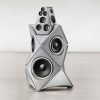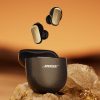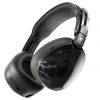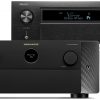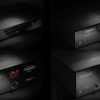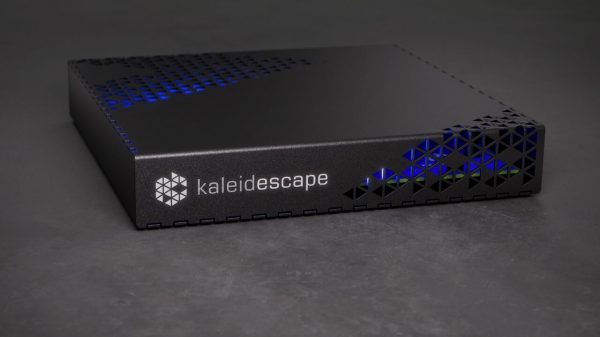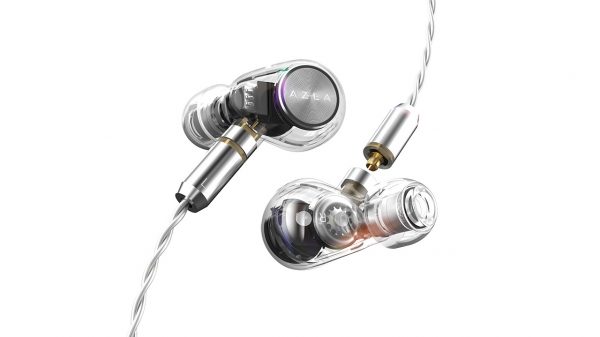I’m a fan of STAX and have been for quite some time as their electrostatic headphones offer performance that few others can match. In my early days, back before Audeze and HiFiMAN re-defined the headphone market with the current planar magnetic trend, most headphones used high impedance dynamic drivers with names like the AKG 240, Beyer DT880, and Sennheiser HD560 Ovation and then there was the STAX SR-Lambda. Introduced in 1988, the STAX SR-Lambda was a completely different offering than any of the other big names in the market. It was an electrostatic headphone that required a special “Energizer” instead of a conventional amplifier and it had a sound like none of the others mentioned as it was built for speed. Transients on that early STAX blew away everything I’d heard. No it didn’t have the bass response of the AKG, or the tonality of the HD560, but sheesh was it fast. That was how and when my love for STAX headphones began and I told myself, someday, I’m going to own a pair of those.

Background
STAX goes back to 1938 and has been making electrostatic ear-speakers ever since in some form or another. The original company went bankrupt in 1995, but was quickly resurrected in 1996 and has been going strong ever since.
In 2011, China’s Edifier acquired STAX but left the company to operate as a mostly autonomous business unit.
Our review of a pair of STAX branded wireless headphones in 2023 represented their first wireless model and a significant departure from their electrostatic lineup.
Fast forward to 2024 and STAX offers 7 models of electrostatic earspeakers and 7 energizers to power them. Prices range from just under $500 for the SR-L300 headphones to $6,200 for the new SR-X9000 flagship.
The energizers cover roughly the same territory with the least expensive offering just shy of $1,000 and the flagship priced at over $6,000.
STAX also faces a lot more competition in 2024 and there are no shortage of flagship headphones from other high-end brands in the $4,000 to $6,000 range that offer dynamic, electrostatic, and planar options.
Electrostatic headphones are a unique product and don’t represent the best option for specific types of listeners; they might offer the best sound quality but that means nothing if you can’t take it with you.
The STAX SR-003 MK2 were designed to flip all of that on its head.
Before you get too excited, there are some things you need to know before taking the plunge.

Electrostatic Caveats
There are a number of issues that you need to consider before buying a pair of traditional electrostatic headphones; they are sensitive to dust so don’t even think of wearing them outside and never get them wet.
Feeding them after midnight might be a bad idea as well.
The price of admission is also higher because of the necessity of the energizer and portable power has never really been an option.
Until now.
I recently got the opportunity to audition the SRM-D10 Mk2 energizer from STAX. That is a great example of how things are changing. The D10 Mk2 is a portable DAC/energizer capable of powering all current STAX headphone models. It is roughly the same height and width as a phone and just over an inch thick so it pairs well with portable devices.
This needs a headphone that can travel well too which is where the “baby” STAX comes in. The SR-003 MK2 is the 4th generation of STAX earphones (by my count) and retails at $350 and offers a more portable listening experience than its larger siblings.
The combination of the D10 Mk2 and SR-003 MK2 retails for $1295 if purchased together. Although not cheap, much more manageable than most flagship in-ears and that combination is exactly what I was sent to audition.

Build Quality
The D10 MK2 as mentioned is roughly the size of a cell phone with the exception of being thicker at 3 inches wide, 5.5 inches tall and 1 ¼ inches thick. Weight is the same as a can of soda at 450 grams. The case is entirely aluminum which helps improve the durability of the energizer and also acts as a heatsink as the little energizer gets warm.
The case does have exposed screws so should the battery need replacing, most qualified audio shops should be able to help without need of special tools.
The front panel of the unit has a large volume knob that doubles as a power switch and the 5-pin DIN connector that supports all 580v pro biased headphones in the STAX lineup.

On the rear of the unit are a 3.5mm line-in port and a USB Type-C input followed by a switch to select between the two and a second USB charge port.
When used with USB input, an XMOS chip handles the transport details to an AKM4493 DAC with the D10 Mk2 offering DSD256 and PCM 32-bit/384kHz playback. MQA is not supported. The analog portion of the D10 Mk2 provides the bias voltage that energizes the screens then the audio signal is passed to the diaphragm itself which reacts to the electrical field produced by the bias current and moves proportionate to the signal.
For this reason wattage as it typically applies to amplifiers is not an appropriate measure when discussing energizers. The D10 MK2 offers 53dB gain and was plenty to power the baby, the SR-L700 and even the mighty SR-009 headphones but is slightly lower than the STAX desktop models which typically operate at 60dB gain.
This is in deference to battery life and even with the reduction the D10 is more transportable than portable as battery life in USB mode is a touch over 3 hours or roughly 4.5 hours when used with the analog input. I’ll readily admit to not understanding why, but the STAX documentation shows a 4 watt power draw for the USB and a 5 watt draw for line-in which would make me think battery life should be the reverse of my findings, but I’m sure there is an explanation were I to have an advanced degree in electronics design.
There is a windows Driver needed to use the D10 Mk2 with Windows 11 (available on STAX website) but it worked without drivers paired to Android, iPhone, and MacBook systems so Windows appears to be the odd man out.

Comfort & Fit
The SR-003 Mk2 headphone/earphones come with the earpieces which can be worn tip down but I had trouble keeping them in place. They can be worn tip up by swapping sides and wearing the left earbud in the right ear which helps a little but not enough. A headband is provided that allow the earpieces to snap in and this is an improvement in stability, but I still had issues getting a good seal.
Part of the issue is the earbuds are rather large with the body being a bit over an inch in diameter and most of the earpiece sits outside the ear so while not heavy, it does tend to move.
Luckily the SR-003 Mk2 loaner came shipped with the CES-A1 accessory kit that in my use should be thought of as a mandatory purchase for those getting the SR-003 Mk2. The CES-A1 contains various tips with hooks that make the 003 way more comfortable as well and allows use without the headband. Without the winged tips the earpieces simply will not stay in place.
The kit also contains covers to convert the 003 into closed back in-ears for those times when open-backs are not welcome. Personally I’d rather see STAX charge a bit more and include the CES-A1 kit as part of the base package as I found it nearly impossible to get a decent seal and good sound without the add-ons. Trust me, if you are trying to use the 003 without the kit, spend the $70 and get one, it’s a huge difference.

Listening Notes
Once you get a good seal, these in-ears are every bit a STAX headphone and they do a good job of blurring the line between in-ear and headphone. It is almost as if the engineers were able to shrink the size of the SR-007 without losing any of its best attributes.
Bass is punchier than many will expect and can be stepped up a notch more by using the closed back kit. Surprisingly, using the closed backs lose very little in clarity compared to the open back and those looking for big bass may find themselves using them as closed backs the bulk of the time.
Bass is extremely well controlled with great texture and detail retrieval so even with a slightly above neutral bass, there is no loss of clarity and no worries about obscuring quieter voices in the mix. Overall, I wish a lot of headphones had as well defined bass and as much sub-bass presence as these in-ears.
Lower voices have good body and tonality and vocals cut through the mix well without sounding artificially pushed. Guitar growl is accurate and tight with the 003 delivering a fun listen on tracks like Social Distortion’s “Ball and Chain” where the guitars cranked to 11 are on full display and Ness’ vocals shine through. Strings have good energy and speed and the 003 seems equally at home delivering Pavel Hass’ Schubert String Quartet No 14, ‘Death and the Maiden’ as they did hammering out Primal Scream.
Upper voices are equally well rendered and stand squarely in front of the instruments again without feeling pushed and vocal groups like Pentatonix are a fun listen as the sound is really very cohesive.
One of the great things that I originally fell in love with STAX for was the ability to deliver a detailed open treble without getting fatiguing so if the 003 couldn’t deliver that, I was going to be royally disappointed. No worries, they deliver. There is good energy and percussion snap is phenomenal and about as real as you’re likely to ever hear.
Cymbals are dead on, and there is no metallic click to be heard anywhere. I would not call the 003 bright as it balances extremely well, but it is very detailed in the upper ranges and proves that there is a difference in bright and detailed that often gets lumped together by lesser models.
The place where the 003 really surprises though is in its stage and imaging. These have a great stage with plenty of room in all dimensions and the ability to make sounds appear at various depths throughout the stage. Tracks like the intro to “Who are you” (The Who) or “So Lonesome” (Cowboy Junkies) are great listens as the 003 creates a vivid picture of the space around the performers.
Bigger ensembles really show off the layering and imaging as seating the orchestra is a non-event with positions defined tightly in space and dimensions seemingly conforming to the track as the stage shape follows the recording being played. The 003 handled everything I threw at it with no sign of compression and the ability to get loud and still deliver the quietest nuances in the background.

Conclusion
The “baby” STAX are quite worthy of carrying the STAX name as sonically they do not disappoint. Sure they lack the comfort of some of my in-ears, and their construction is largely plastic which when combined with the care needed to keep an electrostatic device in top condition means these are not the headphones for a backpack or pool party, but who cares? With sound like this coming from a combination that retails for less than some flagships’ replacement cables, why wouldn’t a few minor annoyances be forgiven?
For years, the knock on electrostatics has been they required special equipment, weren’t particularly portable, required lots of power, and were expensive. All of that is still true, but with the market now having caught up with and surpassed the prices of STAX models, maybe it’s time to re-investigate a technology that has always offered the highest potential sound quality of any headphone type.
Where to buy: $1,295 at staxaudio.com
Related Reading
Shure KSE1200 Electrostatic Earphone System: Review
HiFiMAN’s Mini Shangri-La Electrostatic Headphone System is Only $2,300?
Audeze CRBN Electrostatic Headphones Feature Groundbreaking Carbon Nanotube Technology
Audeze CRBN 2 Electrostatic Headphones Review: Is is time to sell your loudspeakers?


